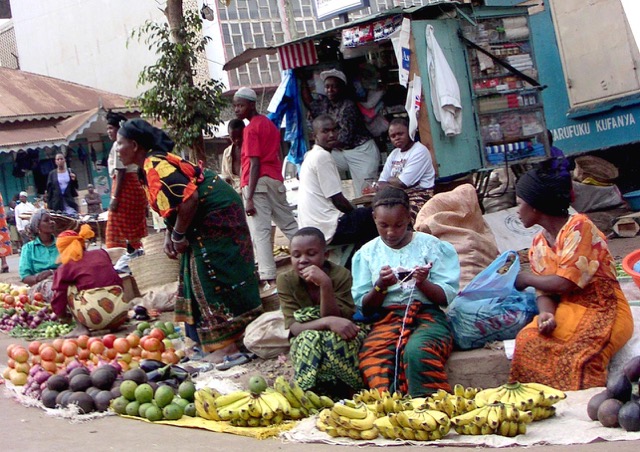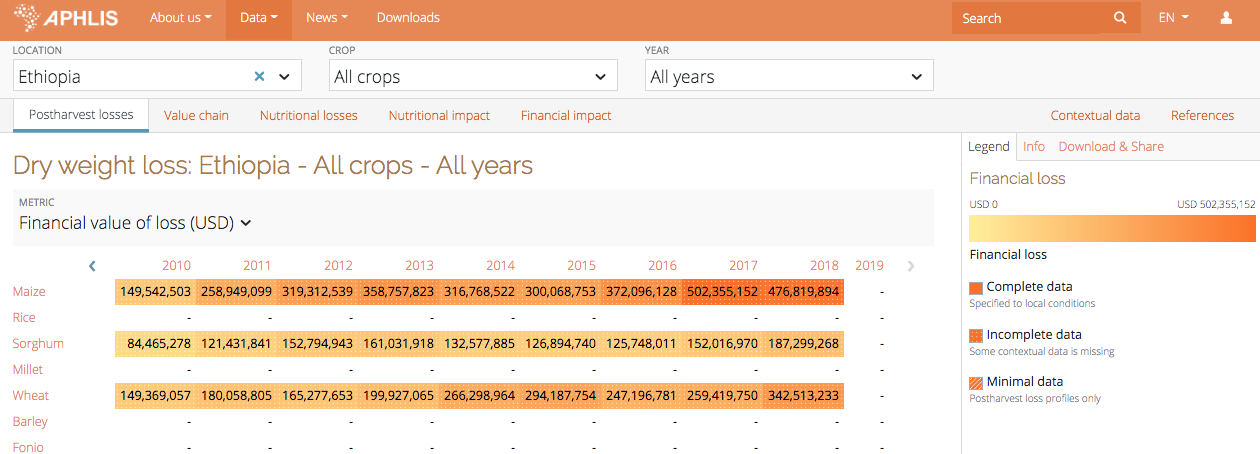New APHLIS tool estimates the financial cost of postharvest losses
(financial values updated 29 July 2022 according to updated price data)
Postharvest losses are widely understood to have serious financial consequences for farmers. Such losses waste not only food, but also the land, water, labour and other inputs used in agricultural production.
The African Postharvest Losses Information System (APHLIS) has developed a new tool that enables users to uncover the financial value of crop postharvest losses in sub-Saharan African countries.
Estimated financial value of postharvest losses in 2018
- In Burkina Faso, the quantity of rice lost postharvest was equivalent to more than USD 30 million.
- In Ethiopia, over 686,000 tonnes of teff were lost postharvest, equivalent to over USD 489 million.
- In Ethiopia, almost 2 million tonnes of maize were lost postharvest, equivalent to almost USD 477 million.
- In Senegal, 11.6% of the rice produced was lost postharvest, equivalent to over USD 75 million.
- In the Kolda region of Senegal, over 29,000 tonnes of rice were lost postharvest, equivalent to over USD 19 million.
What is APHLIS?
APHLIS was created in 2009 to contribute a more accurate understanding of postharvest losses of cereals across sub-Saharan Africa. The aims of APHLIS were to gather, analyse and publicise data on the quantity of each cereal crop lost during harvest, drying, threshing, storage and transport in the different regions of each country every year.
 Marketplace, Kibale, Uganda. ©Neils Photography. Attribution 4.0 International.
Marketplace, Kibale, Uganda. ©Neils Photography. Attribution 4.0 International.
In 2018, postharvest losses of maize are estimated to be worth 500 million USD in Ethiopia alone
APHLIS uses loss measurements recorded in scientific literature, which are then put into context with country-specific data collated by a network of local experts. These data include:
- production figures
- storage duration
- percentage of the crop marketed
- rain at harvest
- pest incidence.
A second phase of APHLIS (2015-2020), supported by the Bill and Melinda Gates Foundation, is expanding the range of crops to include the most important legume, root and tuber crops in African food systems. An additional objective of Phase 2 includes the development of tools to estimate how human nutrition and economic systems are affected by postharvest losses.
How we calculate the financial value of postharvest losses
The tool for estimating the financial value of postharvest losses – released in November 2019 – works by multiplying the number of tonnes of a commodity lost each year during postharvest processes in a particular country (using APHLIS loss estimates) by the price of that commodity.
The APHLIS team screened a number of information systems featuring market price information for food crops, eventually selecting the FAO Global Information and Early Warning System (GIEWS) Food Price Monitoring Analysis (FPMA) tool. This had the greatest overlap with APHLIS in terms of crop, country and years covered. The financial data has been fully integrated into the APHLIS losses tables, enabling users to select various key loss metrics, including percentage loss (%), dry weight loss (t), and the newly developed financial value of loss (USD).
Estimated financial value of postharvest losses of cereal crops in Ethiopia
 APHLIS postharvest loss figures are combined with market price data from the FAO-GIEWS FPMA to calculate the USD value of postharvest losses by crop, country, province and year
APHLIS postharvest loss figures are combined with market price data from the FAO-GIEWS FPMA to calculate the USD value of postharvest losses by crop, country, province and year
Work is ongoing to investigate whether the price discounting effects of postharvest losses on quality, such as those caused by insect damage, can also be integrated into the financial loss calculation tool.
“Adding a financial lens to postharvest loss assessments helps decision-makers decide where to focus their investments around loss reduction.”
“Adding a financial lens to postharvest loss assessments helps decision-makers, donors, and researchers decide where to focus their investments around loss reduction, food security and agricultural production,” said Dr. Tanya Stathers, who led the development of the tool. “It also assists Ministry of Agriculture staff and other stakeholders to leverage national or programme-level resources to invest in training, infrastructure, policy and technology interventions for reducing postharvest losses.”
Users are encouraged to contact APHLIS with information on additional national crop price data sets they would like to see included in the system.
Impact of postharvest losses on GDP
APHLIS has also added datasets that show the financial value of postharvest losses in each sub-Saharan African country in terms of their national agricultural gross domestic product (GDP) and other metrics. Such data can help in developing a deeper understanding of the cost of postharvest losses and the value and importance of reducing postharvest losses by 50% by 2025 in line with the African Union Member States’ Malabo Declaration.
Other recent features added to APHLIS
APHLIS added a tool for calculating the nutritional impacts of postharvest losses in September. Both the nutritional and financial postharvest loss calculation tools can be found on the APHLIS website.
News
Conflict and postharvest losses – the case of Ukraine
27 October 2023
Eighteen months after the Russian invasion of Ukraine, the world faces a massive hunger crisis. The invasion has caused immense suffering for the Ukrainian people and has led to food, fuel, and ferti... Read more ›
Reducing postharvest losses to transform lives: the case of the sorghum value ch...
03 September 2022
Sorghum is a critical crop in Ghana, both for food security and as a source of household income. Mainly grown by smallholders, it is an energy-rich staple that contains essential minerals such as pot... Read more ›
Global agribusiness Olam Agri works with smallholders to measure and reduce loss...
27 June 2022
With a focus on high-growth emerging markets, Olam Agri, the food, feed and fibre global agri-business is determined to improve the sustainability of its supply chains. As a champion of Sustainabl... Read more ›
Policies and strategies to reduce postharvest losses in sub-Saharan Africa: prog...
18 March 2022
The need for more rigorous efforts to reduce postharvest losses is widely recognized. However, policy formulation and implementation are still very slow. Understanding and addressing the reasons behi... Read more ›
Tracking food losses in Africa
03 November 2021
APHLIS is assisting four African countries to estimate the postharvest losses of major root and tuber food crops, a first step in developing more sustainable and efficient food systems. Working with... Read more ›
Side event at the AAPHCE: APHLIS - a tool to support postharvest loss reduction...
08 September 2021
This side event is open to all AAPHCE participants. Introduction Substantial crop losses occur at various stages along the postharvest value chain. The African Union’s Malabo Declarat... Read more ›
Postharvest loss in the era of COVID-19
11 March 2021
Exactly a year ago, the World Health Organization formally named COVID-19 a pandemic. Since then, the virus has swept across the world, leaving over 100 million cases and 2.5 million reported deaths... Read more ›
New APHLIS tool estimates the financial cost of postharvest losses
09 April 2020
(financial values updated 29 July 2022 according to updated price data) Postharvest losses are widely understood to have serious financial consequences for farmers. Such losses waste not onl... Read more ›
APHLIS releases tool for measuring nutritional impacts of postharvest losses
10 December 2019
(updated on 20 March 2020 and 25 February 2021) Postharvest losses do not only squander food, and the land, water, labour and other inputs used to grow crops. A new APHLIS tool reveals the... Read more ›
Postharvest losses and the road to food security
02 September 2019
Food loss includes the physical loss of food as well as quality losses that can diminish the economic value of a crop, or make it unsuitable for human consumption. Food waste, by contrast, refers to... Read more ›